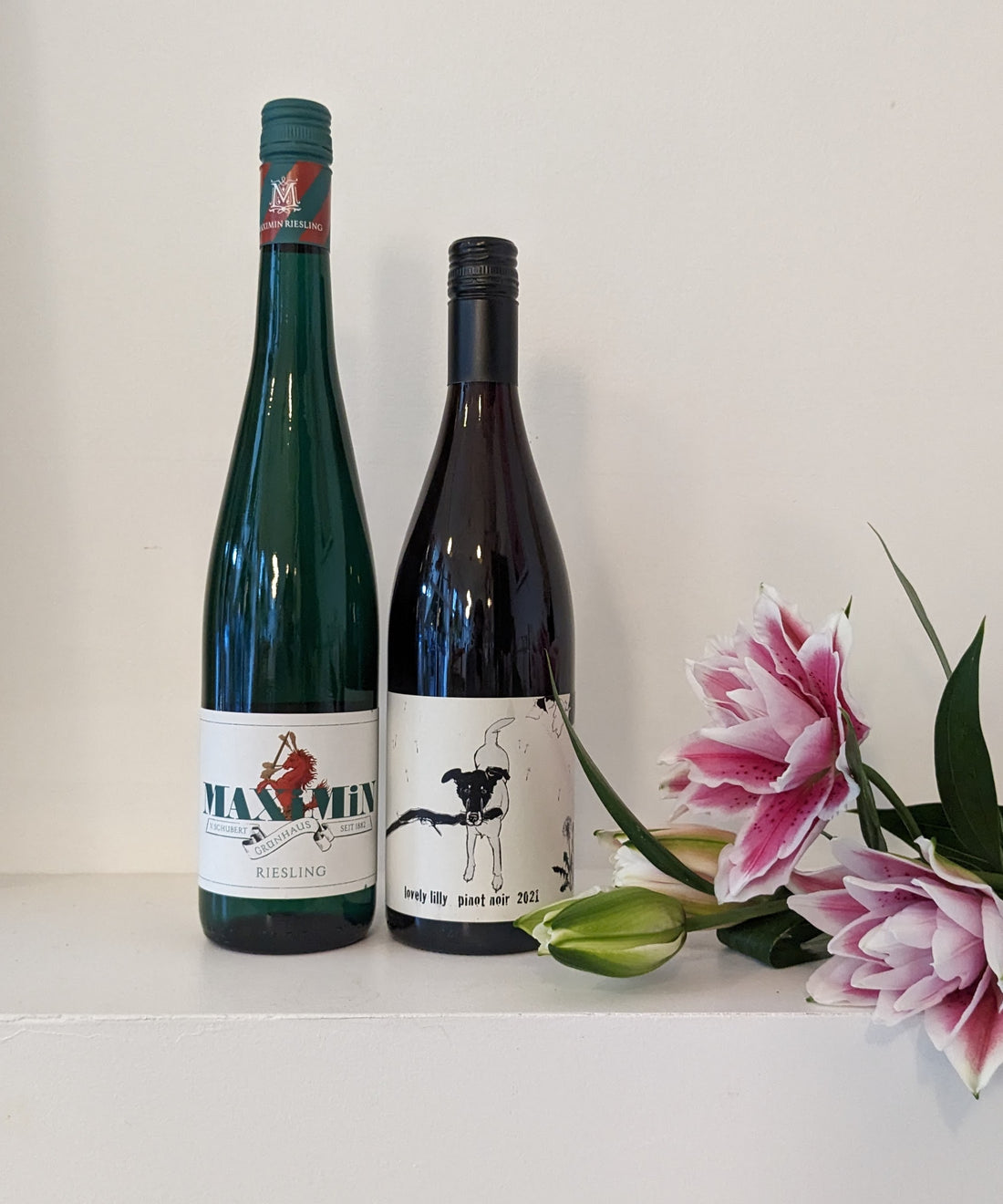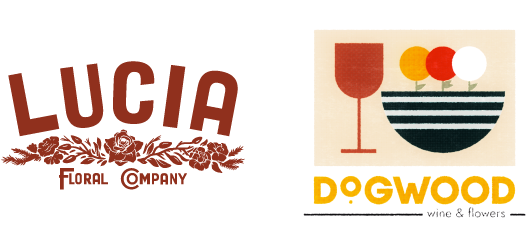
July 2023 - Germany
July 2023
Germany
Featuring:
Maximin Grünhaus
Shelter Winery
There’s few things we love more than breaking down stereotypes and addressing misconceptions about wine regions. It’s safe to say that Germany has a lot of those surrounding it. “All German Rieslings are sweet!” .. “They don’t make any red wine.” .. “Germany has a richer history with beer than wine.” “The labeling system is complicated and doesn’t make any sense!!” - Okay okay, while the last one might be a half-truth, the others are definitely not. To understand more about German wine, let’s go back to the beginning.
History
In ancient times (pre 50 BC), Germany was inhabited largely by Celtic-Germanic tribes that drank primarily Mead (honey wine). They did not understand grape cultivation but, like many ancient cultures, had a rough but important understanding of fermentation. Like many other Western European countries, it was the Romans who brought grape cultivation and wine production to Germany roughly 2000 years ago. Most cultivation was centered around Germany's oldest city, Trier - which was then called Treuorum by the Celts and Augusta Treverorum by the Romans. Trier is located on the Mosel River, in between the confluences of the Saar and Ruwer Rivers. ‘German’ wine was largely focused on this area for several hundred years, until Charlemagne in the 800’s, promoted the expansion of viticulture westward towards the Rheingau and other regions south of modern-day Frankfurt. Lore has it that from his wintertime residence in Ingelheim on the Rhine, Emperor Charlemagne speculated that the snow melting earlier than elsewhere could mean it would be a successful spot for new grape plantings.
Fast forward to March 13, 1435 and we find the first recordings of the Riesling grape, largely attributed to originating in the Rhine region. Riesling is a late-ripening grape particularly suited to Germany’s long and cold growing season. It is speculated that in the mid 1500’s, grapes (and wine) existed in nearly every German region, however with the ensuing wars of the 1600’s, climate change, and ascension of beer, German grape acreage has never reached these heights again. This is the story of the next 500 or so years (to modern day), with grape production largely being confined to the Southwestern corner of Germany and production largely being focused on Riesling and other aromatic varieties. During this time, however, wines from the Mosel and Rheingau in particular gained wonderful notoriety, with figureheads like Queen Victoria being responsible for elevating prices higher than Champagne or Bordeaux in the 16th and 17th century. Over the course of the next few hundred years, many advancements were made, inducing Ice Wine and the German Wine Law & VDP, which is the foundation for all German wine labels, laws, and quality control today. (Note - these subjects are worth understanding for students of wine, but are fabulously complicated to explain and are pending an official change in 2026, so I’ve linked to the robust Wikipedia Articles instead of writing a 3 page exercise in futility.)
Geography & Climate
Much of Germany’s wine production is centered on the Southwestern part of the country, with only two of its 13 regions being found in the Eastern half of the country and none being found in the northern part of the country (above the 51st parallel). Most of the quality production has been focused in the belt from the Pfalz up to the Mosel, including the Rheinhessen, Rheingau, Nahe, and Mosel. Here like Germany’s most legendary producers, almost all of whom produce Riesling as their sole wine. For a wine country, it is fabulously cold in Germany, with frost in Spring, ice in fall, and cool temperatures throughout the growing season. Often, German winemakers will find themselves making wine in October and November, when the Riesling is finally done ripening and other winemakers in the Northern Hemisphere are well into winter activities.
Rather than diving deep into climate (it's cold) or grapes (most people grow, and drink, Riesling), I’d rather showcase each important region and give a sparknote summary to help with further education and wine hunting - enjoy!
Mosel - Incredibly steep vineyards and low production. Blue and gray slate soils impart an intense minerality into the wines. Often considered the best of the best German wines. Generally leaning towards minerality and finesse. Notable producers include Egon Müller, Fritz Haag, JJ Prüm, Schloss Saarstein, Selbach-Oster, Maximin Grünhaus, Zilliken, & many others.
Nahe - Steep slopes as well. Volcanic soils, varying from vineyard to vineyard. Primarily Riesling production, but with more variety and even some red. Notable producers: Dönnhoff, Diel, Dr. Crusius.
Rheingau - South-facing slopes along the Rhine are warmer and prone to more power and body. Historically a great producer of dessert wines but focus today is more on dry wines (~80%). Notable producers: Robert Weil, Georg Breuer, August Kesseler, Leitz.
Rheinhessen - Germany’s largest region in acreage and production. Defined by gently rolling hills rather than steep river valleys. Muller-Thurgau and Dornfelder join Riesling in popularity. Notable producers: Keller, Seehof, Kühling-Gillot, Wittman, Gunderloch.
Pfalz - Similar geography to Rheinhessen. Lower land prices have led to more up and coming winemakers and allowed for more space for innovation. Great for bargain hunting. Notable producers: Von Winning, Dr Bürklin-Wolf, Müller-Catoir, Koehler-Ruprecht.
Baden - Germany’s southernmost wine growing region, directly across from Alsace. Much warmer than those above, it is home to Germany’s best Reds and Grau/Weissburgunder (Pinot Gris/Blanc). Notable producers: Ziereisen, Enderle & Moll
Maximin Grünhaus, ‘Maximin’ Riesling, Mosel 2021
The Grünhaus estate is one of the very few top-tier German estates that farm from a single, contiguous vineyard block. This steep, entirely south-facing block is located on the Ruwer River, about 2 miles upstream from where it meets the Mosel. The estate dates back to the late 700’s (not a typo), where it was called ‘Villa ad Valles’ and donated from a Frankish king to the Benedictine Saint Maximin monastery in Trier. The monks farmed this land for several hundred years until Napoleonic rule and secularization of property put it in the hands of the French Government in 1810.
Here is where some of the uniqueness of Grünhaus gets its origins. Under Napoleonic rule, inheritance laws were changed to state that any property would be split amongst all heirs, rather than given entirely to an heir of the deceased’s choosing (usually an eldest son). This famously caused fragmentation of vineyard ownership in France’s Burgundy region, but the effect was widely felt throughout Germany as well. Many of the most famous vineyard sites in the Mosel and beyond have several (if not more) vineyard owners, some who farm just a few rows. For example, the famed Wehlener Sonnenuhr vineyard has over 200 owners. Grünhaus, on the other hand, was owned first by the Church and then by the state. No personal ownership meant no heirs and no fragmentation. And while it is one continuous plot, it is three separate named vineyards - Abtsberg, Herrenberg, and Bruderberg. All three of these vineyards are monopoles - vineyards owned by one entity. The von Schubert family, who owns the estate today, has been at the helm since the 1800’s. Aptly named Maximin von Schubert represents the 6th generation and has been at the helm since his father’s passing in 2014.
The estate makes some of the most powerful, expressive, and longest-lived Rieslings of the entire Mosel and the wines remain relatively affordable since they’ve never achieved cult-like status with the wealthy, collector crowd (who ruin everything good for us normal people). If you see a signature green bottle of Grünhaus around, my suggestion is to buy it, stash it, and save it in your cellar for a rainy day with spicy or sweet food. We drank a bottle of 2017 Abstberg Spätlese (off-dry) with Thanksgiving last year and the aromas still linger in my memory.
This bottling, ‘Maximin’ is a new cuvee from the estate and, as of its conception in 2021, is their introductory offering. This is farmed from multiple new sites that the estate has purchased near to, but not a part of, their monopoles. It is fermented entirely in stainless steel and produced off-dry, in the typical German style. The residual sugar of 15 g/L might sound worrisome to some, but it is incredibly important to remember that Riesling has such electric acidity that the sugar is balanced with the acidity. The two work in cohesion and temper one another. The incredibly low pH of Riesling would be nearly off-putting if made in a totally dry style. (To put it into perspective, Sprite has roughly the same pH of 3.2, and contains 86 g/L of sugar).
I personally find off-dry Riesling fantastic with any sort of spicy, rich food - usually something Thai or Korean - but you could pair this with just about anything due to the high acidity. Higher expressions, like the aforementioned Spätlese, can b
e happily consumed alone.
Note - One other pro-hack with Riesling. While some wineries have started to put a sweetness scale on the back of the label, it’s not always the case. And as we mentioned with German wine law, it can be a bit confusing. So how do you know if a Riesling (or wine) is sweet or dry? Alcohol percentage! Since alcohol is created when sugar is fermented, there is naturally an inverse relationship between the two. If a wine is over 12% alcohol, it is likely bone-dry, with no perceptible sweetness. If it is in the range of 10-11.5%, it’s probably only a little sweet, maybe not even noticeably. And if it's lower than 10%, there is probably a decent bit of sugar remaining. These are generalizations, but better tools to have than nothing at all!
Shelter, ‘Lovely Lilly’ Pinot Noir, Baden 2021
Hans-Bert Espe and Silke Wolf, founders of Shelter winery, are located in Baden, a warm (for Germany) region on the eastern banks of the Rhine. Sandwiched between Alsace to the west and the Black Forest to the East, Baden is ground-zero for German Pinot Noir, which historically has been rather bombastic, oak-laden, and overripe. Shelter is part of the new movement that’s pushing against this, making wines with higher acidity, leaner body, and more finesse. The name, Shelter, comes from an old Canadian airport hangar that they first rented to make their wines. They’ve since moved to a larger, partially underground facility but that boot- strapped sentiment remains.
The couple farms all of their plots by hand, and uses organic practices in the field. In the cellar, they are relatively hands-off, with a short cold soak, fermentation in open-top vessels, mostly neutral oak barrels, and judicious sulfur use. The results of this hard work are tangible - their Pinot Noirs are simply amazing and set a standard for how great Spätburgunder (German for Pinot Noir) can be.
This wine, named after their old winery dog Lilly, is a wonderful, simple entry point to the category. It is what I call a ‘pleasing wine’ - the punchy red fruit, purple violets, and bright acidity make for a lovely drinking experience. It is admittedly not the most contemplative of Pinots, but that’s not what we’re really after in this price point. I’d drink this on its own and with a light chill, preferably outside on a warm afternoon, and with good company!
